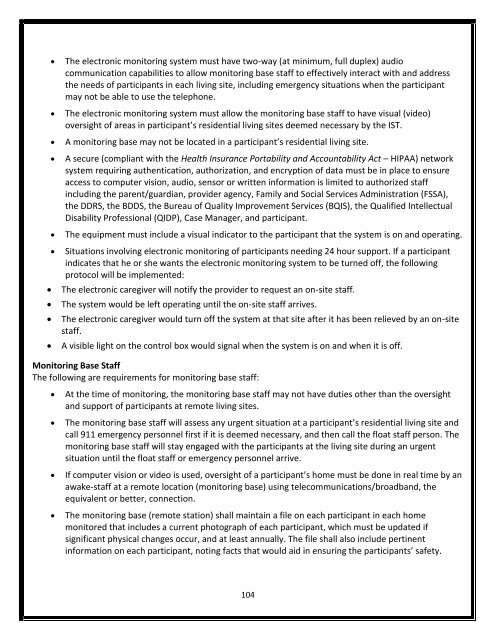DDRS Waiver Manual
2dXf5Pj
2dXf5Pj
Create successful ePaper yourself
Turn your PDF publications into a flip-book with our unique Google optimized e-Paper software.
The electronic monitoring system must have two-way (at minimum, full duplex) audio<br />
communication capabilities to allow monitoring base staff to effectively interact with and address<br />
the needs of participants in each living site, including emergency situations when the participant<br />
may not be able to use the telephone.<br />
The electronic monitoring system must allow the monitoring base staff to have visual (video)<br />
oversight of areas in participant’s residential living sites deemed necessary by the IST.<br />
A monitoring base may not be located in a participant’s residential living site.<br />
A secure (compliant with the Health Insurance Portability and Accountability Act – HIPAA) network<br />
system requiring authentication, authorization, and encryption of data must be in place to ensure<br />
access to computer vision, audio, sensor or written information is limited to authorized staff<br />
including the parent/guardian, provider agency, Family and Social Services Administration (FSSA),<br />
the <strong>DDRS</strong>, the BDDS, the Bureau of Quality Improvement Services (BQIS), the Qualified Intellectual<br />
Disability Professional (QIDP), Case Manager, and participant.<br />
The equipment must include a visual indicator to the participant that the system is on and operating.<br />
Situations involving electronic monitoring of participants needing 24 hour support. If a participant<br />
indicates that he or she wants the electronic monitoring system to be turned off, the following<br />
protocol will be implemented:<br />
The electronic caregiver will notify the provider to request an on-site staff.<br />
The system would be left operating until the on-site staff arrives.<br />
The electronic caregiver would turn off the system at that site after it has been relieved by an on-site<br />
staff.<br />
A visible light on the control box would signal when the system is on and when it is off.<br />
Monitoring Base Staff<br />
The following are requirements for monitoring base staff:<br />
<br />
<br />
<br />
<br />
At the time of monitoring, the monitoring base staff may not have duties other than the oversight<br />
and support of participants at remote living sites.<br />
The monitoring base staff will assess any urgent situation at a participant’s residential living site and<br />
call 911 emergency personnel first if it is deemed necessary, and then call the float staff person. The<br />
monitoring base staff will stay engaged with the participants at the living site during an urgent<br />
situation until the float staff or emergency personnel arrive.<br />
If computer vision or video is used, oversight of a participant’s home must be done in real time by an<br />
awake-staff at a remote location (monitoring base) using telecommunications/broadband, the<br />
equivalent or better, connection.<br />
The monitoring base (remote station) shall maintain a file on each participant in each home<br />
monitored that includes a current photograph of each participant, which must be updated if<br />
significant physical changes occur, and at least annually. The file shall also include pertinent<br />
information on each participant, noting facts that would aid in ensuring the participants’ safety.<br />
104


